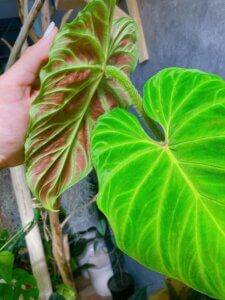Basic Information
Philodendron verrucosum, also known as Ecuador philodendron, is a beautiful houseplant that has vining growth habit and heart-shaped, velvety green leaves. During summer, it blooms with white and pink flowers.



Light
Philodendron Verrucosum is a plant that naturally grows on the forest floors of Central America. It prefers to be placed in a shady spot at home, as it thrives best in highly dappled light. It is important to avoid exposing the plant to direct sunlight on its leaves, as it can cause damage. A good spot for the Philodendron Verrucosum to grow would be an east-facing window that provides bright, indirect light for most of the day, with some direct morning sunlight.
Water
The Philodendron Verrucosum is a tropical plant that originally came from Ecuador. As a plant that loves moisture, it should only be watered once a week. You should only water it when the top two inches of soil feels dry to the touch. Overwatering can harm the plant by causing root rot, yellowing leaves, and stunted growth. To replicate the plant’s natural tropical jungle environment, water it thoroughly but avoid letting the soil dry completely. A pot with a drainage hole and tray is crucial to prevent water from accumulating and saturating the soil.
Soil
For Philodendron Verrucosum, it is recommended to use a well-draining and airy soil mix. The ideal choice for plant health is a mix of 30% potting soil, 30% orchid bark, 30% perlite, and 10% charcoal. This mixture ensures proper drainage and airflow to the roots. If you prefer to create your own soil mix, you can begin with sponge-like coco coir as a base to retain water. Then, add chunky supplements such as orchid bark, charcoal, pumice, etc., to increase drainage and aeration. Lastly, earthworm castings can be added as a natural fertilizer to nourish the plants. It is important to maintain the soil pH between 5.1 to 6.0.
Temperature
This plant requires temperatures above 68°F (20°C) to thrive. If you want to promote its growth, keeping it in warmer temperatures, significantly above 77°F (25°C) and with high humidity, is best. However, extreme temperatures should be avoided. The Philodendron Verrucosum is commonly found in Central and South America and can be grown outside hardiness zones 9b-11 as per the United States Department of Agriculture’s hardiness zones. Ensuring the temperature does not drop below 40°F (4.5°C) is important.
Humidity
Maintaining high humidity levels of over 60% is important for the healthy growth of Philodendron Verrucosum. This plant requires humid conditions that are similar to its natural subtropical and tropical habitat. Some plant enthusiasts even go to the extent of maintaining terrarium conditions with humidity levels above 90%. However, it can be challenging to maintain such conditions indoors. Fortunately, there are a lot of ways to increase the humidity inside your home. You can use a humidifier or set up a pebble tray. You can also mist the plant occasionally or establish it in a bathroom or terrarium to achieve the ideal humidity for Verrucosum.
Fertilizer
It is recommended to fertilize your plant once a month using liquid fertilizer during the spring and summer months. It’s best to use a graded Aroid fertilizer and give monthly doses of moderate concentration. You can choose between slow-release fertilizers or liquid fertilizers, with slow-release varieties applied up to three times a year. This will give your plant the necessary nutrients to grow healthy and strong.
Growth Rate
The Ecuador Philodendron changes color and gains deeper green leaves and faded red undersides as it matures. It can grow large but be pruned and propagated to fit available space. It’s best to use it in larger terrarium projects as it can be challenging to maintain growth in a confined space.
Pet Safety
Philodendrons are toxic to pets due to calcium oxalate crystals. Keep them away from pets to prevent accidental ingestion.
Grow in Semi-Hydro
- Philodendrons, celebrated for their lush foliage and adaptability, thrive in semi-hydroponic systems such as LECA/Pon, thanks to their resilient root systems and preference for consistent moisture.
- Shifting a Philodendron to a semi-hydroponic setting works well using a Nutrient Stagnant Wicking (NSW) method, providing a stable and effective environment for growth.
- Within the LECA/Pon environment, Philodendron roots adapt swiftly, effectively managing any early challenges in adapting to the NSW system.
- For nourishing Philodendrons in semi-hydro systems, a nutrient solution with a concentration around 800-1000ppm is optimal.
- Philodendrons are versatile in adapting to a range of temperature and humidity levels, making them ideal for various indoor settings.
- Regular care involves keeping an eye on the water level in the reservoir and periodically flushing the system to ensure the Philodendron’s healthy and consistent growth.
- If your Philodendron is a climber, it’s a must to look at our Moss Pole guide to have a proper set-up.
Tips
- Pruning: Regularly remove yellow or damaged leaves to promote new growth.
- Repotting: Do this every 2-3 years to provide fresh soil and more room for growth.
- Pest Control: Watch for pests like aphids and spider mites; treat promptly if needed.
- Leaf Care: Clean leaves occasionally with a damp cloth for better light absorption.
- Watch Fertilizer Use: Avoid overfertilizing to prevent root damage.
These additional care tips, along with the basic requirements, will help ensure that your Philodendron Verrucosum remains healthy and vibrant. Remember, observing your plant regularly and adjusting care as needed is essential for its well-being.
Happy planting! 🌱


